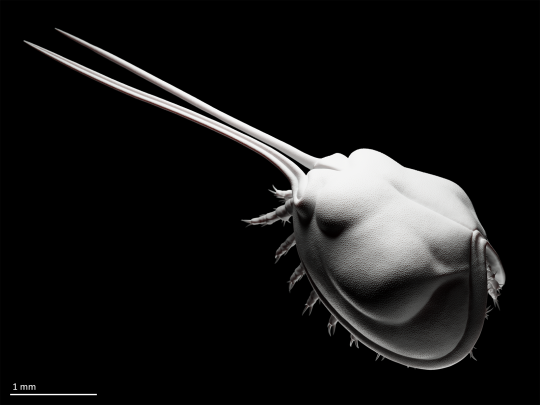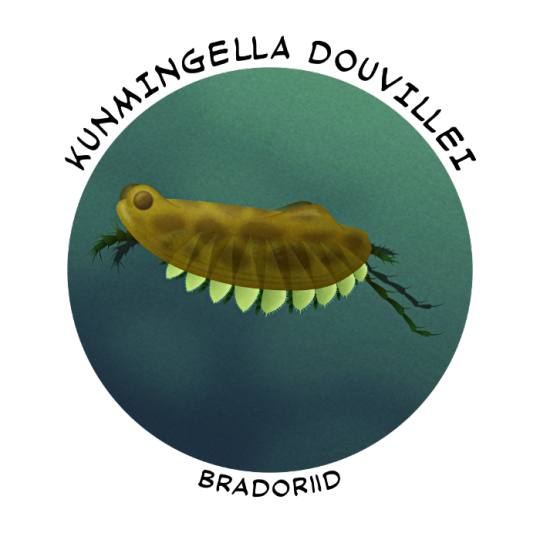#bradoriida
Text

Sculpt of the small bivalved arthropod Gladioscutum lauriei from the middle Cambrian of Australia (after Hinz-Schallreuter & Jones 1994).
Gladioscutum had a body only 2-3 mm long, but, being undoubtedly aware of its disappointingly small size compared to its cooler Cambrian cousins like radiodonts and trilobites, tried to make up for it with a pair of (presumably) front-facing spines that were at least as long as the rest of the head shield.
Other than improving its self-esteem, the function of Gladioscutum's extremely elongated spines is unknown. The enlarged spines of other small Cambrian bivalved arthropods have been suggested to fulfill a sensory role, but this remains speculative (Zhang et al. 2014).
References and notes:
Gladioscutum was originally described as an "archaeocopid", an order that is now known to be an artificial grouping of various small bivalved arthropod fossils superficially resembling modern ostracod crustaceans. To my knowledge, the affinities of Gladioscutum have not been reinvestigated since its initial description, but its appearance (marginal rims, valve lobation, ornamented surface, simple hinge line) and age seem bradoriid-y enough (Hou et al. 2001) for me to more or less confidently reconstruct it as one (top scientific rigour as always on this blog).
Appendage morphology is unknown in Gladioscutum - what little soft anatomy I have not modestly hidden under the head hield is based on the bradoriid Indiana sp. from the Chengjiang Biota (Zhai et al. 2019). In that species, only the antennae are differentiated from the rest of the appendages, which has the double advantage of (1) not making crazy hypotheses about limb specialization in Gladioscutum and (2) giving me fewer different types of limbs to sculpt.
Like Gladioscutum, most bradoriids are only known from their decay-resistant valves, which are often squashed flat in a so-called "butterfly" position. This arrangement has been traditionally interpreted as the life position of the animals, which were implied to crawl over the seafloor like tiny crabs (e.g., Hou et al. 1996). Yet, undistorted fossils of head shields preserved in 3D are almost always closely drawn together, which is similar to the way modern bivalved arthropods like ostracods are articulated (protecting the soft limbs and body) and probably more reflective of the actual life position of bradoriids (Betts et al. 2016), as depicted here.
References:
Betts, M. J., Brock, G. A., & Paterson, J. R. (2016). Butterflies of the Cambrian benthos? Shield position in bradoriid arthropods. Lethaia, 49(4), 478–491. https://doi.org/10.1111/let.12160
Hinz-Schallreuter, I., & Jones, P. J. (1994). Gladioscutum lauriei n.gen. N.sp. (Archaeocopida) from the Middle Cambrian of the Georgina Basin, central Australia. Paläontologische Zeitschrift, 68(3), 361–375. https://doi.org/10.1007/BF02991349
Hou, X., Siveter, D. J., Williams, M., Walossek, D., & Bergström, J. (1997). Appendages of the arthropod Kunmingella from the early Cambrian of China: Its bearing on the systematic position of the Bradoriida and the fossil record of the Ostracoda. Philosophical Transactions of the Royal Society of London. Series B: Biological Sciences, 351(1344), 1131–1145. https://doi.org/10.1098/rstb.1996.0098
Hou, X., Siveter, D. J., Williams, M., & Xiang-hong, F. (2001). A monograph of the Bradoriid arthropods from the Lower Cambrian of SW China. Earth and Environmental Science Transactions of The Royal Society of Edinburgh, 92(3), 347–409. https://doi.org/10.1017/S0263593300000286
Zhai, D., Williams, M., Siveter, D. J., Harvey, T. H. P., Sansom, R. S., Gabbott, S. E., Siveter, D. J., Ma, X., Zhou, R., Liu, Y., & Hou, X. (2019). Variation in appendages in early Cambrian bradoriids reveals a wide range of body plans in stem-euarthropods. Communications Biology, 2(1), Article 1. https://doi.org/10.1038/s42003-019-0573-5
Zhang, H., Dong, X., & Xiao, S. (2014). New Bivalved Arthropods from the Cambrian (Series 3, Drumian Stage) of Western Hunan, South China. Acta Geologica Sinica - English Edition, 88(5), 1388–1396. https://doi.org/10.1111/1755-6724.12306
#i'll probably make more art of cambrian bivalved arthropods with fucked up spines#because there is no shortage of them#and they still manage to all look rather distinct#gladioscutum#bradoriid#(?)#arthropod#cambrian#paleozoic#australia#paleontology#palaeoblr#paleoart#my art
34 notes
·
View notes
Photo

Cambrian Explosion #47: Bradoriida
The tiny bradoriids first turn up in the fossil record just before the earliest known trilobites, about 521 million years ago, and very quickly became some of the most abundant euarthropods in the mid-Cambrian. Found all around the world, they were clearly important components of many Cambrian food webs and probably had varying lifestyles from species to species, ranging from living on the seafloor to actively swimming around in the water column.
Less than 2cm long (0.8"), they're mostly known just from fossils of their bivalved carapaces, but some specimens preserve evidence of a pair of antenna and varying arrangements of biramous and uniramous limbs.
They were traditionally thought to be crustaceans closely related to ostracods, but some studies have instead shifted them towards being considered stem-crustaceans or stem-mandibulates instead. And more recently rare high-detail preservation of the soft anatomy of a few species have suggested they actually belong even further down the arthropod evolutionary tree, as "higher stem" euarthropods positioned between the megacheirans and the earliest actual euarthropods.
Kunmingella douvillei is one of the best-known bradoriids, with its fossils being incredibly abundant in the the Chinese Chengjiang fossil deposits (~518 million years ago). About 5mm long (0.2"), it had two different types of biramous limbs and a couple of pairs of uniramous limbs at the back.
Some female specimens have been found preserved with eggs, carrying up to 80 on their rear biramous limbs, representing some of the oldest evidence of brood care in the fossil record.
After their initial success the bradoriids gradually declined through the late Cambrian, but a few species persisted into the Ordovician and they finally went extinct sometime around the middle of that period – which was also around the time that the ostracod crustaceans began to appear and diversify.
———
Nix Illustration | Tumblr | Twitter | Patreon
#science illustration#paleontology#paleoart#palaeoblr#cambrian explosion#cambrian explosion 2021#rise of the arthropods#kunmingella#bradoriida#euarthropoda#arthropod#panarthropoda#ecdysozoa#protostome#bilateria#eumetazoa#animalia#art
104 notes
·
View notes